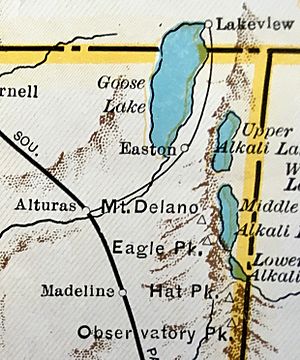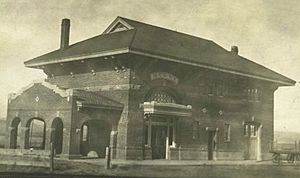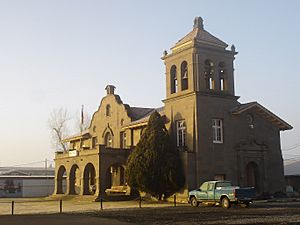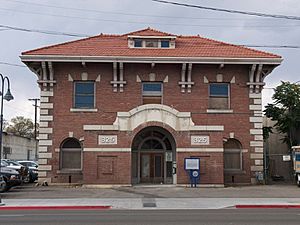Nevada–California–Oregon Railway facts for kids
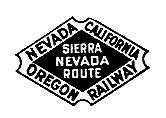 |
|
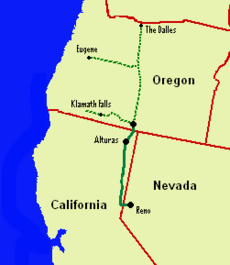
Original plan for NCO rail network
|
|
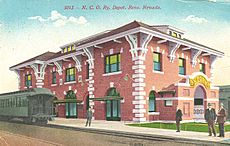
NCO station in Reno, Nevada
|
|
| Overview | |
|---|---|
| Headquarters | Reno, Nevada (1880-1918); Alturas, California (1918-1925) |
| Locale | California, Oregon, and Nevada |
| Dates of operation | 1880–1925 |
| Successor | Southern Pacific Company |
| Technical | |
| Track gauge | 3 ft (914 mm) |
| Length | 238 mi (383 km) |
The Nevada–California–Oregon Railway (N-C-O) was a special kind of train line. It used a narrow gauge track, which means the rails were closer together than regular tracks. This made it cheaper to build.
The N-C-O was supposed to connect Reno, Nevada, all the way to the Columbia River. But they only built about 238 mi (383 km) of track. So, the trains never went further than Lakeview, Oregon. People sometimes joked about the company's problems, calling it the "Narrow, Crooked & Ornery" railroad.
Contents
The Story of the N-C-O Railway
The N-C-O Railway started in Reno in June 1880. Back then, it was called the Nevada and Oregon Railroad. The idea was to build north to the Columbia River. This would help cattle ranches and farms in northeastern California and eastern Oregon. The goal was to reach The Dalles, Oregon, a city on the Columbia River.
The company chose to use narrow gauge tracks. This was because it cost less money than building standard tracks. Work on the railroad began in December 1880. The first spike was hammered in Reno on May 28, 1881.
However, the company often didn't have enough money. This made building the tracks very slow. Also, the people in charge had many disagreements. Sometimes, there were even two groups trying to run the company at the same time!
The railroad reached Oneida, California, in October 1882. This town was about 30 mi (48 km) north of Reno. Regular train service between Reno and Oneida started a month later. But building tracks was still slow, and the company's money problems grew.
A bank from New York, Moran Brothers, was the biggest investor. In April 1884, the bank took over the railroad. They bought the company for over $372,000. For the next few years, the company worked on making the existing lines better. They also tried to get more local businesses to use the train.
On January 1, 1893, the railroad's name was changed. It became the Nevada–California–Oregon Railway.
Building More Tracks
The next big push to build tracks north began in 1899. By April 1902, the line reached Madeline, California. The tracks then went to Likely, California, in October 1907. In December 1908, they arrived at Alturas, California. Finally, on January 10, 1912, the tracks reached Lakeview, Oregon.
The company had big plans to keep building north. They wanted to go through Prineville, Oregon, to The Dalles. They also planned branches to Klamath Falls and the Rogue River Valley. Another branch was planned over the Cascade Mountains to Eugene, Oregon. But none of these extra tracks were ever built.
Changes and Challenges
By 1910, the train engines were changed to run on oil instead of wood. The railroad's best year for money was 1913. But after that, things got harder. More people started using other train lines. These included the Western Pacific Railroad and a Southern Pacific line.
In 1915, the N-C-O bought some used trains and cars. They got two engines, three passenger cars, two mail cars, and 78 freight cars. These came from another railroad that was closing down. They bought them for a low price of $22,750.
In 1917, the company started selling off some of its smaller lines in California. The next year, the Reno station closed. The main office and repair shop moved to Alturas. By 1922, the railroad was in serious financial trouble. The Moran Bank wanted to stop owning the business.
On April 30, 1925, the Southern Pacific Company bought the N-C-O. By 1928, Southern Pacific had changed all the N-C-O tracks to standard gauge. This meant they were wider. They also sold off the narrow gauge equipment. Some of the old N-C-O engines were used on other narrow gauge lines.
Today, a part of the old N-C-O line is still used. The 54.45-mile (87.63 km) section between Lakeview and Alturas is now run by Lake County, Oregon. It's called the Lake County Railroad. It connects with the Union Pacific at Alturas.
Train Stations
The Nevada–California–Oregon Railroad built beautiful brick depots (stations). They had them in Reno and Lakeview. A smaller stone station was built in Alturas.
All three of these old passenger stations are still standing today. They are even listed on the United States National Register of Historic Places. This means they are important historical buildings. The old engine house and machine shop in Reno are also on this list.
The N-C-O railway office in Alturas and the depot at Lakeview show a style of building from the 1880s. It's called Mission Revival. This style often has strong, thick walls, wide roofs that stick out, and arches like old Roman buildings.
Here are some of the main stations:
- Reno depot: The architect who designed this station was Frederick DeLongchamps.
- Alturas depot: This station was built by Martin and Diamond.
- Lakeview depot: Frederick DeLongchamps also designed the Lakeview station.
Locomotives (Train Engines)
The N-C-O Railway used many different train engines over the years. Here is a list of some of them:
| Number | Builder | Type | Date | Works number | Notes |
|---|---|---|---|---|---|
| Santa Cruz | H.K. Porter, Inc. | 0-6-0 | 1875 | Built for the Santa Cruz and Felton Railroad; purchased in 1881 for use during construction; sold to Lake Valley Railroad in 1884 | |
| 1 | Baldwin Locomotive Works | 4-4-0 | December 1884 | 7527 | purchased new; retired 1915 |
| 2 | Baldwin Locomotive Works | 4-4-0 | December 1884 | 7528 | purchased new; retired 1918 |
| 3 | Baldwin Locomotive Works | 4-4-0 | August 1887 | 8791 | purchased new as Erasmus Gest; moved to SP's Carson and Colorado Railway (C&C) in 1928. Not used by SP. Tender to SP #14. |
| 1st #4 | Baldwin Locomotive Works | 2-8-0 | September 1888 | 9518 | purchased new as Charles Moran; sold to Tonopah Railroad in 1904 |
| 2nd #4 | Baldwin Locomotive Works | 4-6-0 | October 1899 | 17124 | purchased new as #6 Camya; renumbered in 1904; moved to C&C in 1928; not used by SP; tender to SP #14. |
| 5 | Baldwin Locomotive Works | 4-6-0 | November 1899 | 17123 | purchased new as Amedee; rebuilt 1925; moved to C&C in 1928 |
| 2nd #6 | Baldwin Locomotive Works | 4-6-0 | April 1903 | 22020 | purchased new as #8; renumbered in 1904; moved to C&C in 1928 |
| 7 | Baldwin Locomotive Works | 4-6-0 | April 1903 | 22012 | purchased new; moved to C&C in 1928. Not used by SP. Tender to SP #17. |
| 8 | Baldwin Locomotive Works | 4-6-0 | August 1907 | 31445 | purchased new; moved to C&C in 1928 |
| 9 | Baldwin Locomotive Works | 4-6-0 | November 1909 | 34036 | purchased new; moved to C&C in 1928 |
| 10 | Baldwin Locomotive Works | 4-6-0 | 1910 | 34528 | purchased new; became Pacific Coast Railway #110 in 1929 |
| 11 | Baldwin Locomotive Works | 4-6-0 | December 1911 | 37398 | purchased new; became Pacific Coast Railway #111 in 1929 |
| 12 | Baldwin Locomotive Works | 4-6-0 | December 1911 | 37394 | purchased new; moved to C&C in 1928; renumbered SP #18 |
| 14 | Baldwin Locomotive Works | 2-8-0 | April 1914 | 41300 | purchased new; moved to C&C in 1928; renumbered SP #1; to Nevada County Narrow Gauge #9 in 1933. |
| 22 | Schenectady Locomotive Works | 4-6-0 | November 1899 | 5399 | built as Florence and Cripple Creek Railroad #22; purchased 1915; moved to C&C in 1929 |
| 23 | Schenectady Locomotive Works | 4-6-0 | January 1900 | 5420 | built as Florence and Cripple Creek Railroad #23; purchased 1915; retired 1921 |


